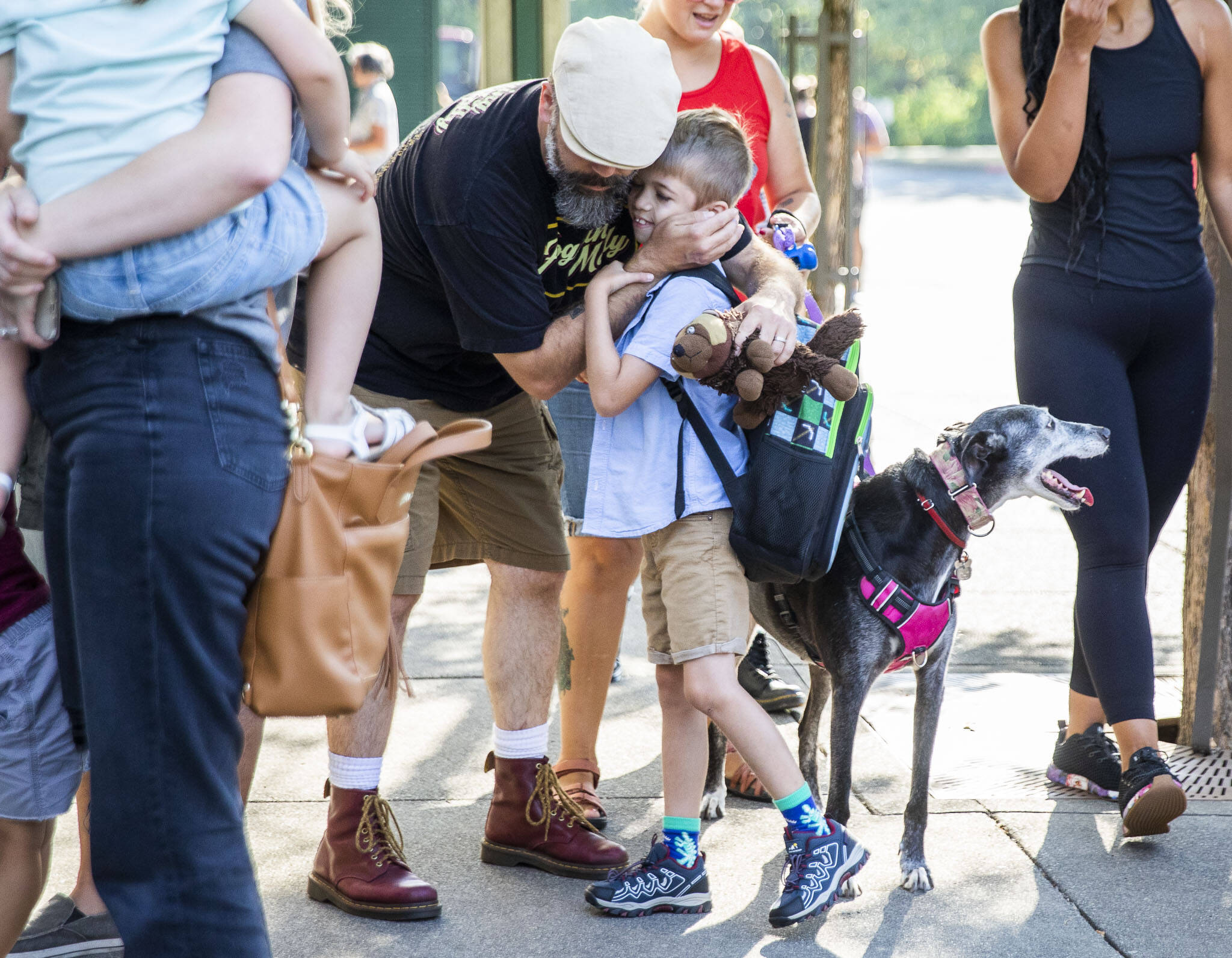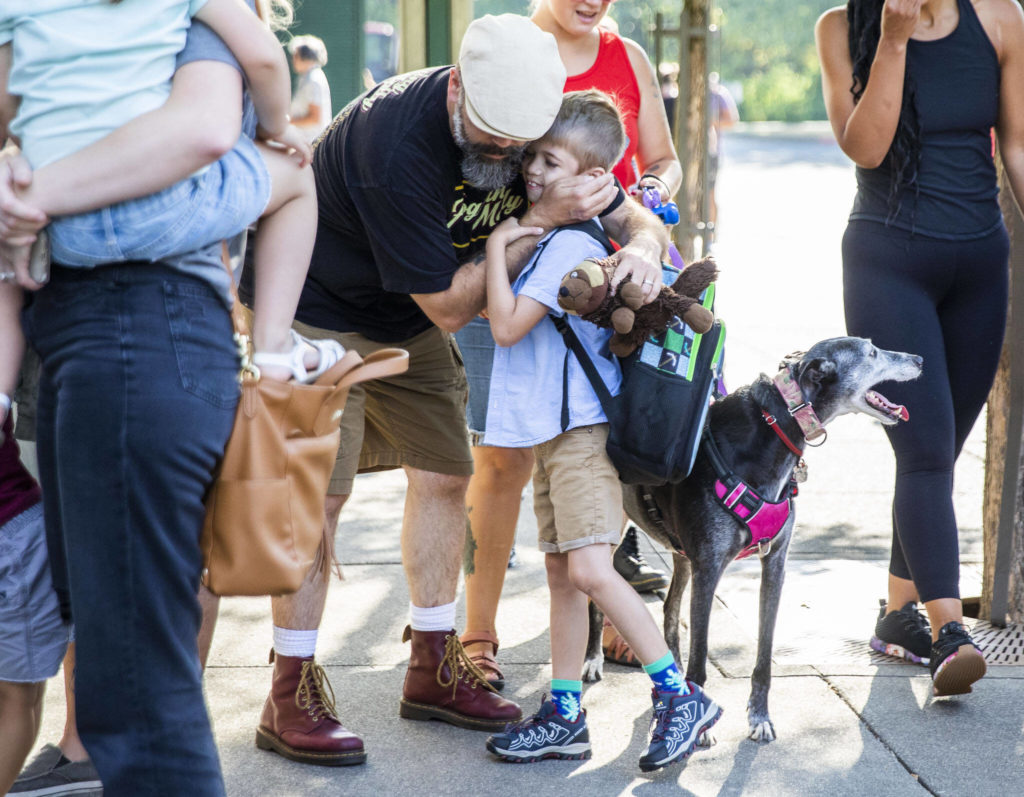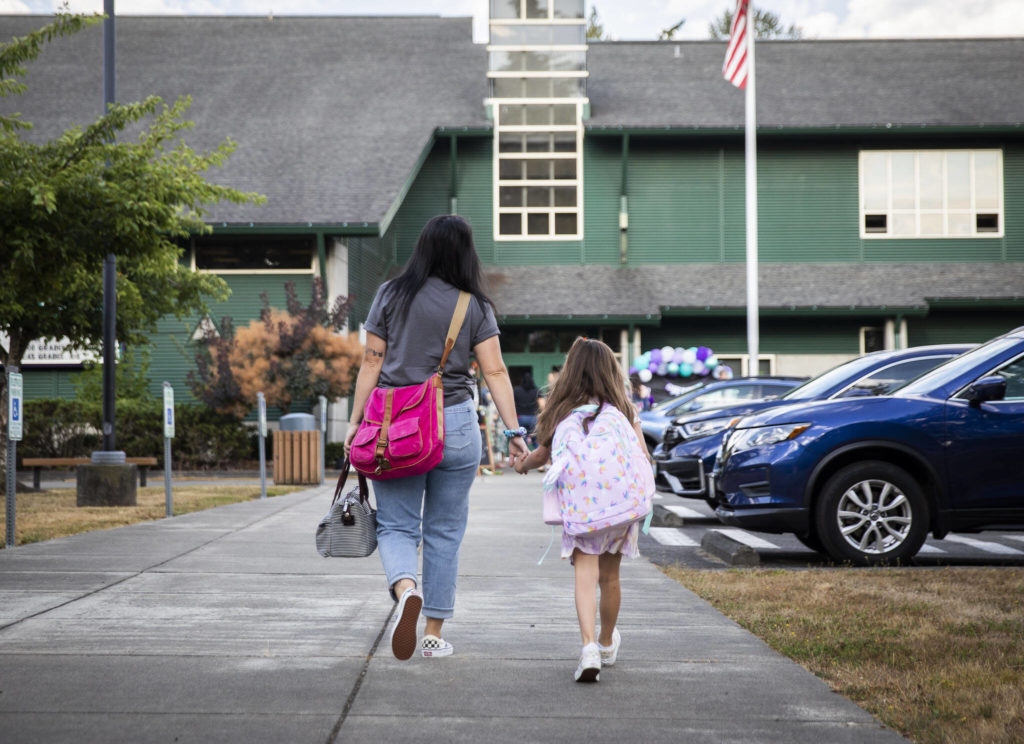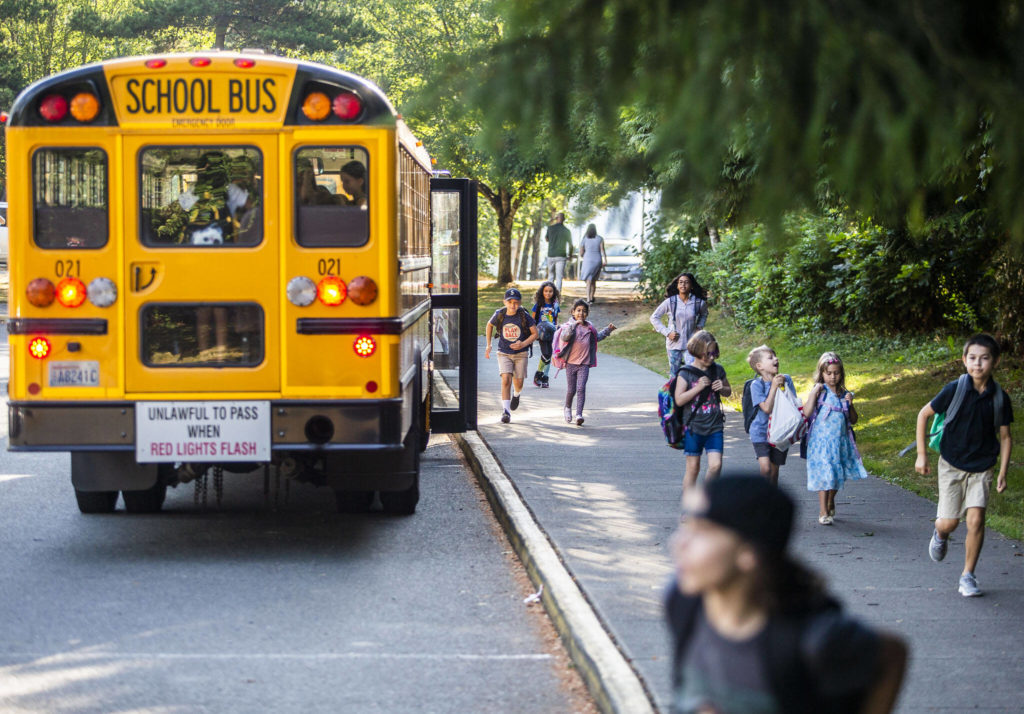LAKE STEVENS — With his gelled hair, a black-dotted button up shirt and a few gaps in his teeth, incoming first-grader Jack Leary made small talk among a crowd of students, parents and staff outside Highland Elementary School on Wednesday.
He was ready for his first day of class. His mother Shantel Leary said returning to classes this year felt “a lot more normal.”
“It feels so long since a first day of school when we didn’t have to worry (about COVID). … We can think about outfits and other regular things,” she said.
A year ago, back-to-school preparations meant measuring distances between desks, retooling class schedules to ensure social distancing in cafeterias at lunch time and stocking up masks because everyone had to wear them indoors.
This year, it’s about lesson plans, enrichment programs and counseling services. COVID, too, but less than before.
“I’ve been telling people that we had to have last year so that we could get to this year,” Lake Stevens Superintendent Ken Collins said. “Last year was difficult for folks in a lot of different ways.”
School leaders saw firsthand how the pandemic hurt students academically. Standardized test scores in Washington dropped several points between 2019 and 2021. According to the state report card, about 60% of students met state standards in English language arts and about 50% met standards in math during the 2019 testing period. In 2021, those rates dropped to about 50% for English and 30% for math.
COVID also took a toll on students’ mental health. According to the Healthy Youth Survey, the percentage of 10th-graders in Snohomish County who reported feeling anxious or nervous in the past year rose from 66% in 2016 to 70% in 2021. A pandemic-focused study by the Centers for Disease Control and Prevention found more than one-third of high school students experienced poor mental health last year, and 44% reported feeling “persistently” sad or hopeless.
In response, schools are amping up academic support efforts. They are bracing for another year of higher-than-normal numbers of incidents requiring intervention and discipline. With one year of in-person classes during a pandemic under their belts, school employees have a better sense of what to expect in 2022-23.
“We were surprised by the level of need we saw from students (last year),” Collins said. “I think we did a great job of meeting those needs, but it wasn’t as systematic as it is going to be this year. I think we are really well prepared this year.”
Part of those preparations in Lake Stevens — the first Snohomish County-based district to officially return to classes — included adding a dean of students in every school. Those deans will dedicate their focus to helping improve attendance and respond to discipline, said school district spokesperson Jayme Taylor.
“From what I’ve heard out in the buildings, our staff have appreciated that,” Taylor said. “It was a big load for them last year to be able to support all of our students’ needs, and these positions will directly help that.”
Lakewood School District added counselors at elementary schools for students with social and emotional needs, a dean of students at the middle school and a behavioral specialist to help teachers develop ways to respond when a student’s behavior becomes an issue.
“What we learned last year was we needed more robust support services across the spectrum,” Lakewood Superintendent Scott Peacock said.
Like many districts last year, Lakewood dealt with shortages of teachers and substitutes. If one was out, other teachers were deployed during their break period to cover for them. In some districts, administrators stepped in to lead classrooms or oversee recess when other staff was out.
Peacock said the shortages were very stressful. This year, the district is building a pool of substitutes and has filled most of its positions. Still, Peacock expects days where there may not be enough educators — especially if some teachers fall ill and need to quarantine.
Chronic extended absences due to COVID were a huge challenge for educators in the Snohomish School District last year, said Justin Fox-Bailey, president of the Snohomish teachers union. They worked hard to create a sense of normalcy for students. Behind the scenes, they were covering each others’ classes, working through break periods and navigating the same pandemic-related difficulties all families faced.
“You had sort of the compounding of it, where if your colleague has been out for five to 10 days, and you haven’t gotten your planning time, you are working extra hard,” he said. “You are covering classes. … And then you get sick, or you just can’t keep up.”
Snohomish teachers are “generally more optimistic” that this school year will run smoother than last, but they remain realistic that the pandemic is not over yet, Fox-Bailey said.
“We think we are past another major COVID wave, but we don’t know that,” he said. “COVID restrictions seem to be easing significantly, but what needs are our students or our families bringing in that we have yet to see?”
Some staffing shortages remain for bus drivers, custodians, food servers and teacher aides. The severity varies by district.
Tory Kartchner, president of the Mukilteo teachers union, said the district is still “facing a difficult staffing situation.” His peers hope the problems will be “less bad” than last year.
“It can’t be worse,” he said.
In the Darrington School District, just two positions are vacant: a paraeducator and a long-term substitute.
“We are very fortunate,” Darrington Superintendent Tracy Franke said. “We have a lot of teachers available in our community, so I think we are ready to start.”
While COVID is in the back of her mind and her schools are still following state health guidelines, Franke said she isn’t focusing as much on the pandemic. She is directing her attention to “meeting students where they are” and celebrating the return of long-held traditions, like the back-to-school barbecue.
This will be the first time since 2019 that the district holds the gathering. It will be the first of many family events hosted by the school district, Franke said.
“We are excited to get those traditions back up and going,” she said.
Other school districts welcomed the return of typical back-to-school events. Something as common as the first day assembly at Cavelero Mid-High School in Lake Stevens felt more energized this year, Superintendent Collins said. On Wednesday, he visited most of the schools that opened for the year.
Buses ran on time, he said, and students looked ready to learn.
“Last year, we were focused on just all the technical things around COVID. This year, we are focused on student achievement academically, socially, social-emotionally and behaviorally,” Collins said. “That’s a really good feeling.”
Mallory Gruben is a Report for America corps member who writes about education for The Daily Herald.
Mallory Gruben: 425-339-3035; mallory.gruben@heraldnet.com; Twitter: @MalloryGruben.
Jerry Cornfield: 360-352-8623;
Talk to us
> Give us your news tips.
> Send us a letter to the editor.
> More Herald contact information.




























